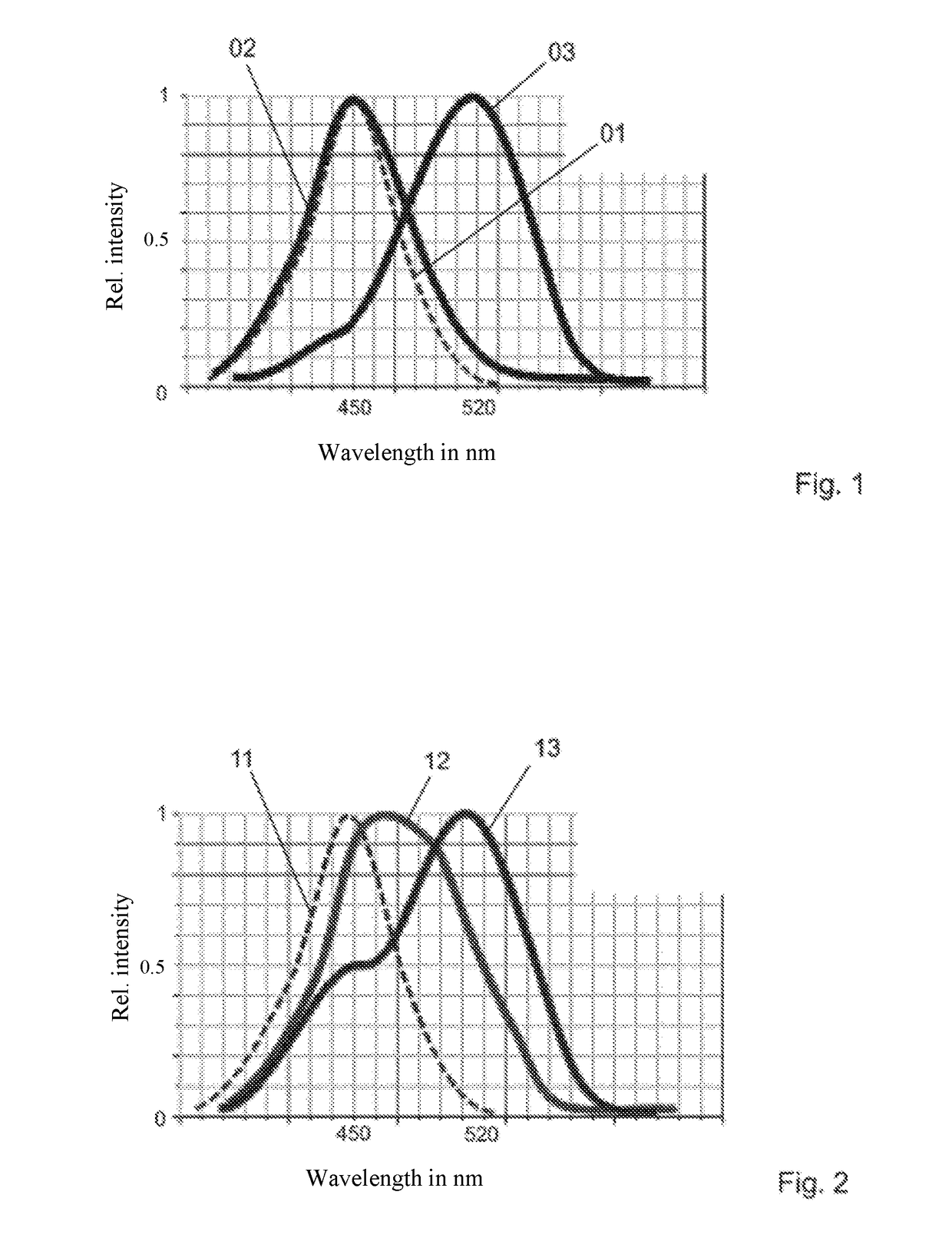Zinc sulphide phosphor having photo- and electroluminescent properties, process for producing same, and security document, security feature and method for detecting same
a zinc sulfide phosphor and photo- and electroluminescent technology, applied in non-fibrous pulp addition, instruments, papermaking, etc., can solve the problems of high cost, difficult to demonstrate, and very strict detection technique requirements, and achieve reliable stationary detection and high-speed detection
- Summary
- Abstract
- Description
- Claims
- Application Information
AI Technical Summary
Benefits of technology
Problems solved by technology
Method used
Image
Examples
example 1
[0096]1.742.6 g ZnS, 2.3948 g CuSO4*5H2O, 4.352 g BiI3, 2.614 g AlF3 and 52.275 g S are thoroughly mixed. For this purpose, all known mixer types such as V mixers, tumblers or round-bottomed pot mixers are suitable. The mixture is filled into dish made of fused silica and covered with a graphite dish containing 1.74 g activated carbon; the annealing dish is closed off with a cover made of fused silica. In a chamber furnace, the reaction takes place in a 5% H2 / 95% N2 atmosphere at 1.000° C. within 3 h. After repeated washing with hot water and deagglomeration using ceramic beads and with the addition of the grinding aid choline base, the material is treated for several hours with 32% hydrochloric acid. The phosphor that has been washed again is subjected to secondary doping with 0.1 g Cu per kg phosphor and, after drying, is tempered for 2 h at approximately 500° C. Finally, a treatment with 1:10 dilution of nitric acid occurs, followed by renewed washing with water, drying, temperin...
example 2
[0097]11.592 g ZnS, 33.526 g CuSO4*5H2O, 4.032 g BiI3, 36.596 g AlF3 and 365.925 g S are thoroughly mixed as in Example 1. In each case ⅙ of the mixture is filled into a respective dish made of fused silica and covered with a graphite dish containing 12 g activated carbon per kilogram phosphor; the annealing dish is closed off with a cover made of fused silica. In a push-through furnace, the reaction takes place in a 5% H2 / 95% N2 atmosphere at 850° C. to 1.000° C. within 3 h. After repeated washing with hot water and deagglomeration using ceramic beads and with the addition of a potassium silicate solution as grinding aid, the material is treated for several hours with 32% hydrochloric acid. The phosphor that has been washed again is subjected to secondary doping with 0.15 g Cu per kg phosphor and, after drying, is tempered for 2 h at approximately 500° C. Finally, a treatment with a 1:10 dilution of nitric acid is carried out, followed by renewed washing with water, drying, temperi...
example 3
[0098]11.592 g ZnS, 33.526 g CuSO4*5H2O, 4.269 g BiI3, 6.2 g AlCl3, 69.552 g MgAl2O4, 10 g BiI2, 30 g NaI, 30 g NH4Br and 365.925 g S are thoroughly mixed as in Example 1, wherein care must be taken to largely exclude humidity. In each case, ⅙ of the mixture is filled into a respective dish made of fused silica and covered with a graphite dish containing 12 g activated carbon per kilogram phosphor; the annealing dish is closed off with a cover made of fused silica. The reaction takes place in a push-through furnace in a 1.5% H2 / 98.5% N2 atmosphere at 850° C. to 1.100° C. within 3 h. After repeated washing with hot water and deagglomeration using ceramic beads, and with addition of a pyrophosphate solution as grinding aid, the material is treated for several hours with 32% hydrochloric acid. The phosphor that has been washed again is submitted to secondary doping with 0.1 g Cu per kg phosphor and, after drying, is tempered for 2 h at approximately 500° C. Subsequently, a treatment wi...
PUM
| Property | Measurement | Unit |
|---|---|---|
| wavelength range | aaaaa | aaaaa |
| wavelength range | aaaaa | aaaaa |
| wavelength range | aaaaa | aaaaa |
Abstract
Description
Claims
Application Information
 Login to View More
Login to View More - R&D
- Intellectual Property
- Life Sciences
- Materials
- Tech Scout
- Unparalleled Data Quality
- Higher Quality Content
- 60% Fewer Hallucinations
Browse by: Latest US Patents, China's latest patents, Technical Efficacy Thesaurus, Application Domain, Technology Topic, Popular Technical Reports.
© 2025 PatSnap. All rights reserved.Legal|Privacy policy|Modern Slavery Act Transparency Statement|Sitemap|About US| Contact US: help@patsnap.com



